List of Authors
>>About this blog
Recent blog post
|
[Hikoharu Co., Ltd.]
Nov. 30, 2018 18:00
This project is also to walk along the ruins of a real river in Chuo-ku.
And the river is Sakuragawa.
Sakuragawa was called "Yachimachibori" in the Edo period. (It is said that the length from the estuary was a moat in about eight towns. And the current notation has been changed to "Hatchobori". ) Then, in 1880 (1880), it was changed to Sakuragawa by Tokyo Metropolitan Government. It is said that "Sakuragawa" was changed to "Kaedegawa". Shin-Sakurabashi, Sakurabashi, Nakanohashi, Hatchobori Bridge, and Inari Bridge were bridged. Sakuragawa joined the Kamejima River (Minato 1-chome) from the junction of the Kaede River and the Kyobashi River, at the time of Danshobashi (Shintomi 1-chome). Landfill construction of Sakuragawa began in 1960 (1960), and construction up to Hatchobori Hashimoto-ryu was completed in 1972. And the estuary that had been left until the end was reclaimed in 1986 (1986), and Sakuragawa will disappear.
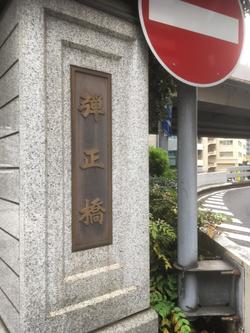 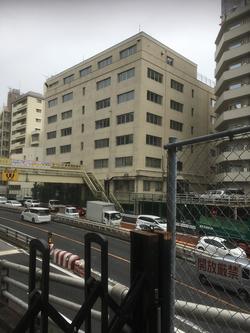
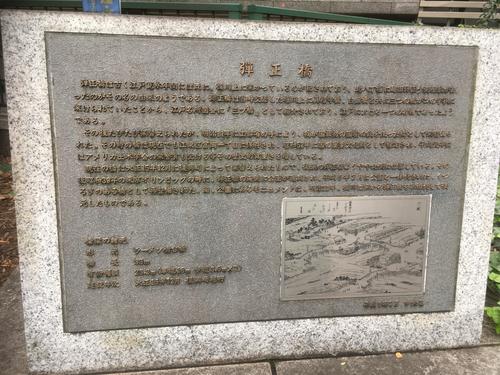
It will be a start from Dansho Bridge. The Kaede River originally flows under the Dansho Bridge, and Sakuragawa starts at the time of this bridge. At present, Kaedegawa is at the Metropolitan Expressway, and cars were flowing instead of water. And when it comes to Danshobashi, it is famous as one of "Mitsuhashi". You may go to the 11th Chuo-ku Tourism Test next year. If you have forgotten it, you need to review it.
Currently, at the confluence of Sakuragawa and Kaedegawa, the buildings of the Metropolitan Expressway Co., Ltd. Shintomi Branch Office and the Metropolitan Police Department Expressway Traffic High Speed Police Corps are built.
 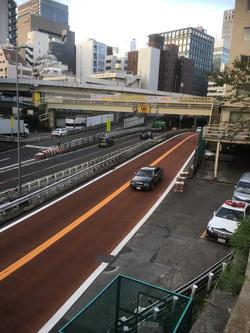
From Shin-Sakurabashi, go toward Hatchobori, and it is near Sakurabashi. The lower left is a photo of Sakurabashi pumping station. And the lower right is the site of Labor Square Tokyo. All of them were located on the site of Sakuragawa.
It seems that there is a plan to build a base facility for lifelong learning centered on the library on the site of Labor Square Tokyo.
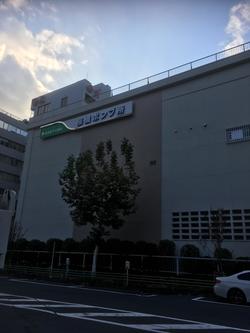 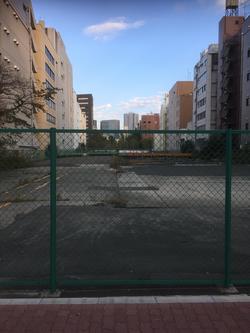
Then, from the vicinity of Sakurabashi, follow Kajibashi-dori toward Hatchobori.
You can see Keika Square on your right hand. Originally, where Keika Elementary School was located, there is still a quaint building, such as using curves with a large curved corner.
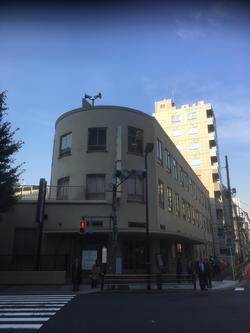 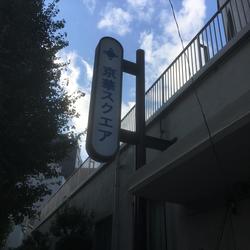
In front of this Keika Square, there is an explanation board for "Hatchobori's Powerful / Concentric Kumiyashiki Ruins".
Speaking of Hatchobori, it is synonymous with the powers and concentrics under the town magistrate, and when I was young, I remember that lines such as "Yachimachibori's husband" were used. .
It means that power and concentric mansions were concentrated near Kayabacho from the northern shore of this "Yachimachibori".
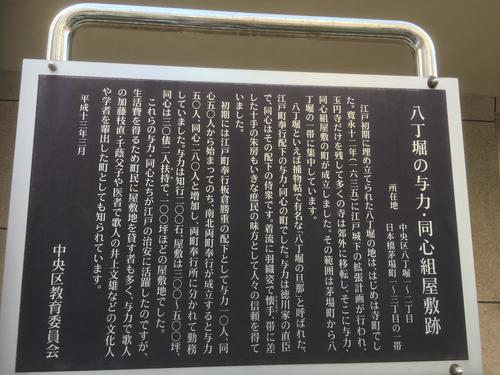
And when you walk to Shin-ohashi-dori St., you will already be Hatchobori Station.
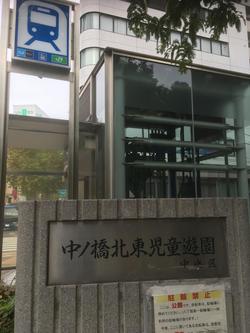 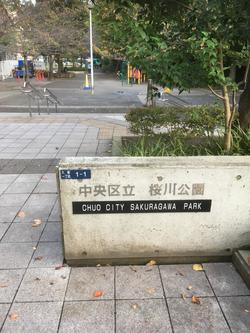
Immediately next to it, there were the nameplates of "Nakanohashi Tohoku Children's Amusement Park Chuo-ku" and "Chuo-ku Sakuragawa Park". . I thought it was a little strange, but I walked on the site of Sakuragawa this time! It's a great nameplate.
I used both of them. Yes, this Hatchobori station is near Nakanohashi, which was over Shin-ohashi-dori St.
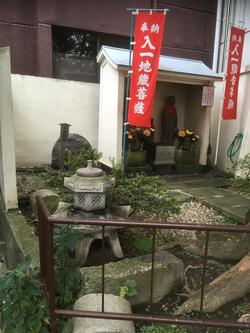 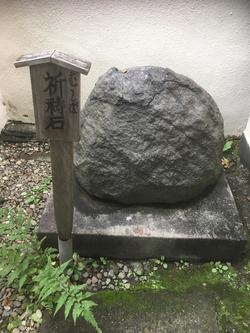
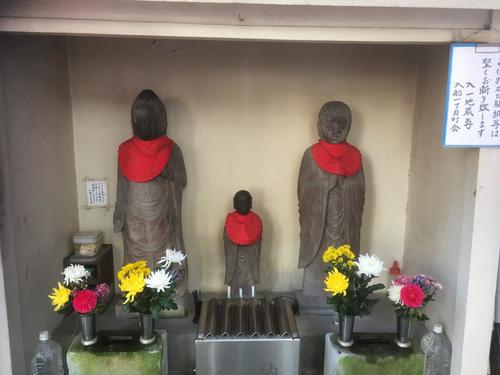
In the bridge at the entrance of Sakuragawa Park, there are Iriichi Jizo Bodhisattva and Iriichi Kannon Bodhisattva. I also looked into this guardian of children and travelers and Kannon.
It seems that there was before the Sakuragawa was reclaimed, but there was no clear material left when it was built. . It is said that it is still managed by the Neighborhood Association of Irifune instead of Chuo-ku. Also, next to Jizo and Kannon, there is a tooth decay prayer stone, and those whose teeth hurt prayed for healing. I was able to get a glimpse of the Japanese folk religion.
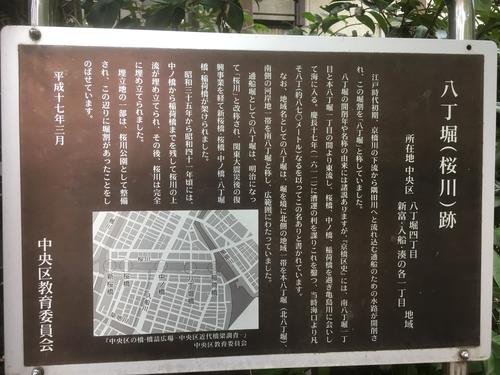
In Sakuragawa Park, there is also an explanation board for the site of Hatchobori (Sakuragawa).
Then, when you pass through the park, "Sakuragawa Nursery School in Chuo-ku, Tokyo", "Sakuragawa Keirokan in Chuo-ku, Tokyo", "Chuo-ku Women's Center Bouquet 21", "Chuo-ku Sakuragawa Rooftop Park" etc. are built, and the site of Sakuragawa is Chuo-ku It is effectively used for parks and facilities.
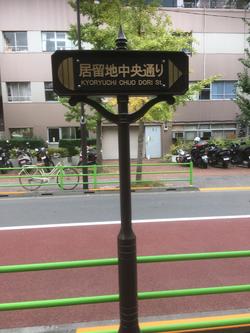
And the road between Sakuragawa Nursery School, Sakuragawa Keirokan, Chuo Ward Women's Center, and Sakuragawa Rooftop Park will be "Remaining Chuo-dori". Proceed south on this settlement Chuo-dori, you will continue to the Tsukiji Foreign Settlement Site (now Akashicho District), which was established in 1868. "Residential Chuo-dori" It's a wonderful naming that reminds you of a foreign settlement that you don't have now.
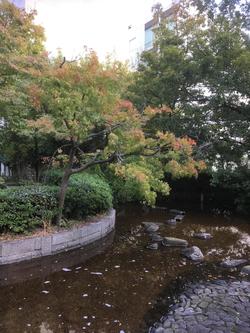 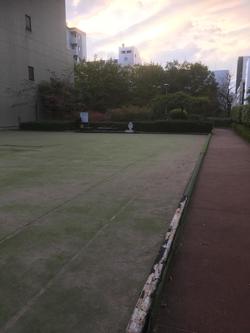
Then, this "Sakuragawa Rooftop Park" cannot be reckoned. There was a garden on the rooftop, and the water flowed, making it a healing spot that made you forget the hustle and bustle of the city. There was also a large open space, making it an attractive park.
 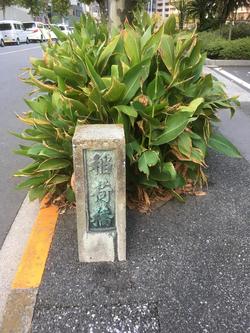
And when you get off Sakuragawa Rooftop Park, the street in front will be "Tetsugunsu Street".
If you go south, of course you will continue to Tepposu Inari Shrine. There was a bridge name plate of Inari Bridge at the mouth of the Sakuragawa River. It's the Kamejima River in front of you.
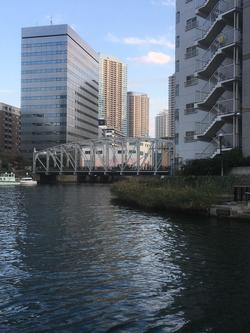 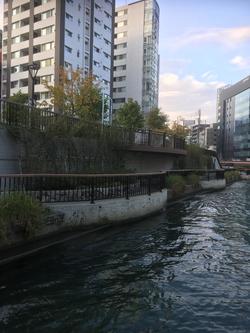
The photo on the left is a photo of Minami Takahashi from the site of Inaribashi.
The photo on the right is near the mouth of the Sakuragawa site. It's almost time for this city walk to the end.
Through this walk around the city, Sakuragawa was not buried for the reconstruction of earthquakes like other reclaimed rivers in Chuo-ku, the reconstruction of wars, and the holding of the Tokyo Olympics, but Chuo Ward Parks and facilities were built. I understand well that it is being used effectively. In addition, the name Sakuragawa was left in the municipal park and facility.
Even so, what will be built on the site of Labor Square Tokyo?
[The Monkey]
Nov. 30, 2018 14:00
Tojotei, the younger brother of Yoshinobu, the 15th shogun of Edo shogunate, known for his writings on the nameplate of Nihonbashi, is located in Matsudo City, the 18th son of Mito feudal lord Nariaki Tokugawa and the mansion of Akitake Tokugawa. The only residence of the Tokugawa family in Meiji period is open to the public in Japan. I went to a house and garden surrounded by colored leaves.  
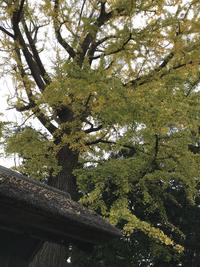 
At the age of 13, Akitake was given the status of a general candidate and was greeted by a general family. In 1867, he was dispatched to the Paris World Exposition as a general representative. In order to overcome the plight of the Shogunate in cooperation with France, Akitake visited five countries other than France, interacted with the heads of each country, and was introduced in a British newspaper as "Prince Tokugawa". . Among the missions who traveled to Europe together at this time, there were people who learned a lot from Western civilization, such as Eiichi Shibusawa, Yuzuru Sugiura, Ryoun Takamura, and Shuntaro Hoshina, who opened Japan's first bank in Nihonbashikabutocho, who worked hard to modernize Japan. In Japan, while the party was in France, the Shogunate broke down, and Akitake returned to Japan to become the last Mito feudal lord, the first governor of the Mito clan. The 16th general became a illusion.
A detailed article about Eiichi Shibusawa is written by correspondent Hanes.
/archive/2018/11/post-5683.html
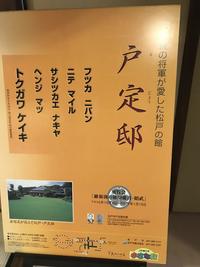 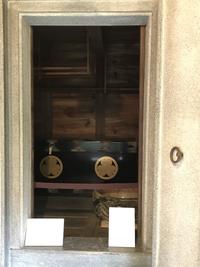
After that, Akitake moved to this Todate residence and lived in Meiji period while fulfilling his sometimes responsibilities as a former Shogunate family. He has many hobbies such as hunting, river fishing, pottery, photography, etc. Among them, architecture and gardening were highly evaluated, and Todate House was recognized as a nationally designated important cultural property, and gardens were recognized as nationally designated scenic spots.
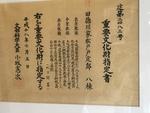 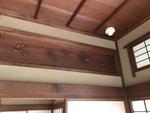 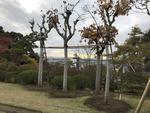
From the garden on a small hill, it seems that you could see the Edogawa River and Mount Fuji at that time, and his close brother, Yoshinobu, also visited. The history museum on the same site is decorated with letters, furnishings, and goods from the Tokugawa family. I remember the quiet Meiji period of the Tokugawa family who left the seat of power.
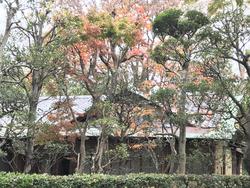
Matsudo City Todate History Museum 714-1 Matsudo, Matsudo, Matsudo, Matsudo Tel.047-362-2050
Admission time 9: 30a.m to 4: 30p.m Closed Monday
[Harumi Madam]
Nov. 29, 2018 09:00
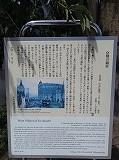 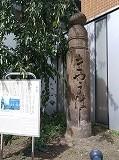
Hello. This is Harumi Madame.
It's the first time I've written it. 。
A while ago, on a pleasant sunny autumn day, I purchased a one-day  bus ticket for the city bus and walked around the city. bus ticket for the city bus and walked around the city.
From Nihonbashi, the starting point of the highway, take the Chuo-dori (Tokaido) to the west with Brabra. The intersection of Kyobashi in no time while watching the remarkable redevelopment scenery.
Do you want the balustrade with giboshi remaining here?
Kyobashi is the official bridge of Edo shogunate, along with Nihonbashi and Shimbashi. In other words, it was a high-class bridge under the direct control of the Shogunate.
There are various theories about when Kyobashi was created, but it is said that it was created together with Nihonbashi around 1603 (Keicho 8).
The Kyobashi River, which had flowed down now, was reclaimed and the bridge was gone, but the Kyobashi railing with giboshi remains at the intersection.
There is a legend in this giboshi. 。 。
"I'm going to stop coughing." When the cough doesn't stop, if you wrap a rope around this giboshi and make a wish, the cough is strangely relieved. 。 。 It seems that the common people of Edo believed this.
In the past, I had a cold and stopped coughing for more than two months, so I remembered it and came here (laughs).
I didn't tie the rope, but it was a coincidence that the cough stopped strangely two days later ...
The giboshi decoration of Kyobashi survived even if the bridge was replaced, and the remaining main pillar railing giboshi was replaced by Ishibashi in 1875.
It's getting cold. It's a cold season. If your cough doesn't stop, why don't you warm up and wish this giboshi?
[Hanes]
Nov. 28, 2018 18:00
Hello. This is a new correspondent, Hanes.   The other day, during the lunch break on a business trip to Osaka, I rushed to a place related to Chuo-ku.  That's Tsukuda in Nishiyodogawa-ku, Osaka!
I guess there are many readers who heard Tsukuda? That's right. Tsukuda in Osaka is related to Tsukuda Island in Chuo-ku.  Tsukuda Island in Chuo-ku was reclaimed by fishermen who entered Edo from Tsukuda-mura, Nishinari-gun, Settsu-kuni (currently Nishiyodogawa-ku, Osaka-shi), and was formed in the first year of Shobo (1644). So why was it built by fishermen in the distant Settsu country? The reason for this was on a little edge. In Tensho 14 (1586), Ieyasu Tokugawa visited Osaka Sumiyoshi Taisha Shrine and Settsu Tada Shrine. At that time, it was the fishermen of the main character Tsukuda who served as the ferry of Kanzakigawa.  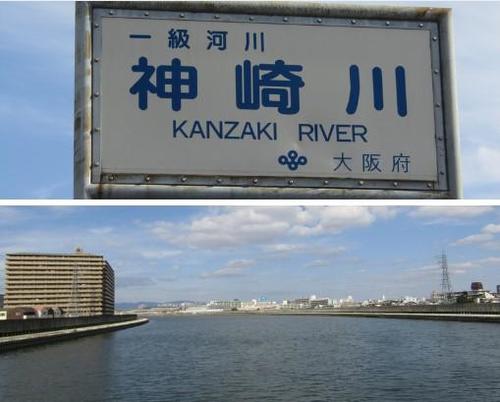 (On the left side is Tsukuda) In Keicho 17 (1612), they were ordered by the Shoguns to serve as fish offerings, and 33 fishermen from Tsukuda and Owada, including the younger brother of Miyaji Tamino Shrine and Magoemon Mori of Tsukuda Village, entered Edo. They were given the privilege of fishing rights, such as being able to fish in any sea in Japan and being exempt from tax. Initially, they lived in Nihonbashikoamicho and engaged in fishing in Edo Bay. Reclaimed the land of the gunshot, which was later received from the Shogunate, and created it. It was named "Tsukuda Island" after his hometown and moved to Japan.  Later, the remaining fish donated to the Shogunate were arranged on board boats and sold to the general public. It was the beginning of the Nihonbashi Fish Bank that I introduced the other day. 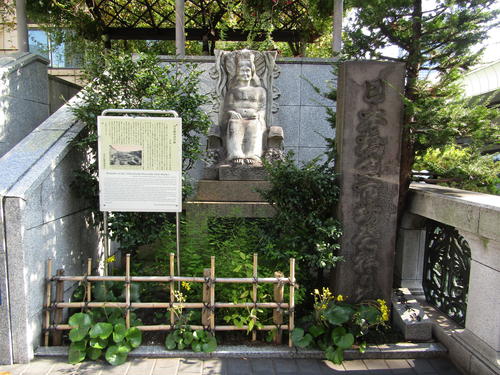 The shrine is located in Tsukuda, Osaka, which enshrines the Ogami of Sumiyoshi. 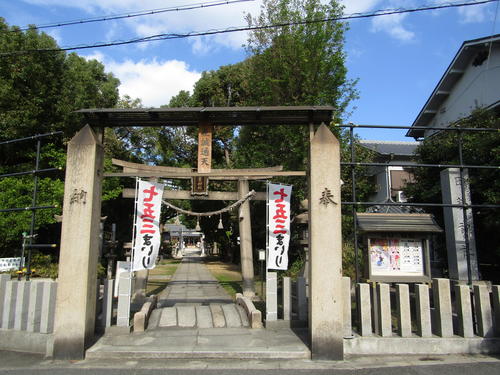 There is a monument about fishermen who have greatly contributed to the development of Chuo-ku.   On the grounds, there is also Toshogu Shrine, which was enshrined after Ieyasu's death, indicating the special connection between Tsukuda and the Shogun's family.  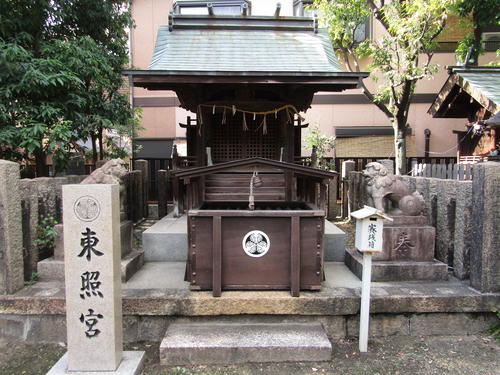 And the grave of Magoemon Mori, a representative of fishermen, is located at Masayuki-ji Temple near the shrine. According to the temple, there is the intention of descendants, and it is not currently open to the public due to preservation.  However, at Tsukiji Honganji Temple in Chuo-ku, you can see Magoemon Mori Peace pagoda.  This was built in 1861, his 200th anniversary. 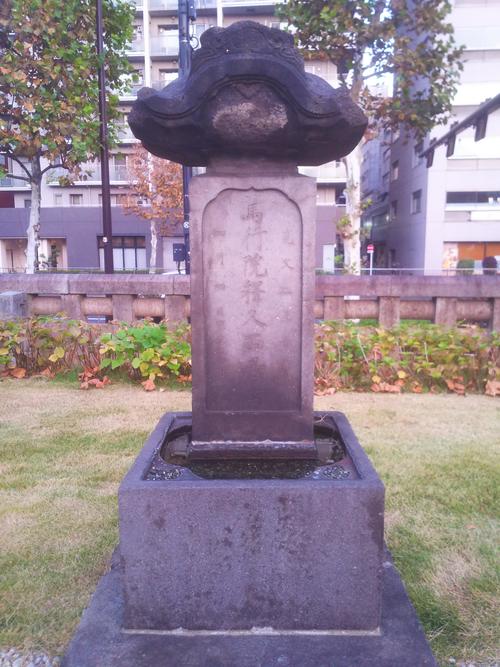 The right side is the relationship between the fishermen of Tsukuda Island and the Tokugawa family, and the left side is engraved with the formation of Tsukuda Island. 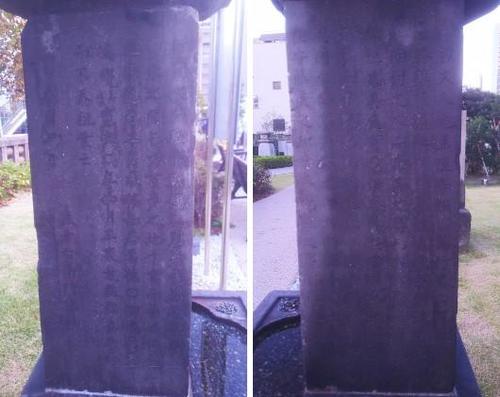 (Right: right side, left: left side) Finally, candidates for the Chuo-ku Tourism Test will introduce the cultural property related to Tsukuda that they want to check, "White Fish Offering Box" This was used by a fisherman on Tsukuda Island to offer white fish to the general. An inner box painted in red (the lid is written with gold mud as "Gozen white fish box Tsukudashima") It is said that it was placed in a black lacquered sandwich box (which is written in vermilion lacquer as "Gozen Gohonmaru") and transported through a katsugi stick.  Goyo fishing was carried out from November to March every year using the net fishing method, a type of fixed net. You can also see it in the Edo Famous Zoukai. When you spotlight the fishermen in this way, can you naturally see their lives? Fishermen who moved to Edo with a mysterious connection from Tsukuda, Settsu country. The edges that they connected were not only the edges of the Shoguns, but also the edges of Edo and Settsu.  Even today, students from Tsukudajima Elementary School in Chuo Ward and Tsukuda Elementary School in Osaka City interact with each other. There is still a good relationship on the island connected by fishermen.  [Reference Materials] Osaka Asobo (Osaka Asobo) "Walking in the land related to Chibune Station (Hanshin Main Line) Tsukuda fishermen"[Site useful for measures against cultural properties in tourism certification] Chuo-ku “Chuo-ku Cultural Properties” http://www.city.chuo.lg.jp/smph/kusei/syokai/tyuobunkazai/(A more detailed book version can be borrowed from the library in the city  .) [Aside] During the Edo period, Tsukuda Island, which separated the sea slightly from the city, was an attractive place for people in the city. Fujimimono, Sumiyoshi-jinja Shirine Festival and clam digging seemed to have become tourist attractions. The situation is depicted in "Edo specialty Kago" and "Picture Book Edo Souvenir".
[Asunaro]
Nov. 26, 2018 18:00
Thanksgiving Day and Niiname-no-Matsuri.
Thanks for the new grain, Niiname-no-Matsuri prayed for a good harvest.
On February 17, the festival was held against Kinen-sai.
It is served at shrines all over the country.
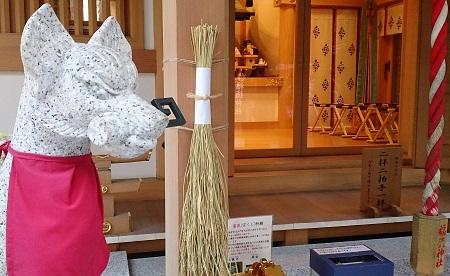
The tax was paid by Yamatohime-no-Mikoto, who dedicated Amaterasu Omikami to Ise.
It is said that the harvested rice ears were put in front of God.
Shrines in various places are also taxed in front of the shrine.
In the past, rice was used as a substitute for money.
The tax suspension is said to be the origin of the current tax.
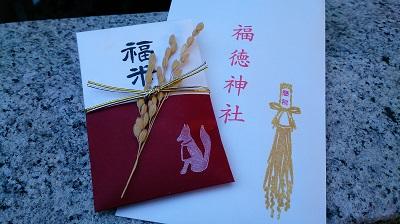
There is a custom that gives you great blessings by eating sacred food.
Rice ears grown in Kanda of Fukutoku Shrine in a noshi bag filled with new grains.
It is "Fukume" which was inserted and purified in front of God.
The award starts on the day of Niiname-no-Matsuri and the number is limited.
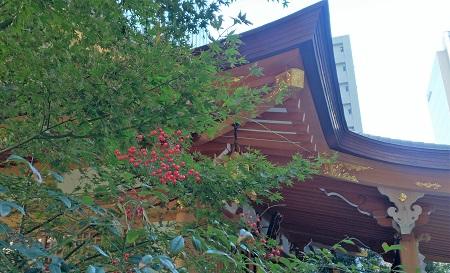
For the work of many people until delicious rice is lined up on the table.
I want to appreciate it.
◆Fukutoku Shrine
2-4-14, Nihonbashimuromachi, Chuo-ku, Tokyo
[CAM]
Nov. 25, 2018 12:00
For the first time in a long time, I read Ryotaro Shiba's "Ryoma Goes". When I first picked it up a long time ago, I was not a resident of Chuo-ku yet, but now I lived in Chuo-ku for more than 16 years, I was familiar with the place names mentioned in the text, etc. I was able to read while remembering the excitement again.
When Ryoma first came out to Edo, he moved to the Tosa Domain's Kajibashi Domain's residence, and then moved to the Tosa Domain Tsukiji Domain's residence. According to Ryoma Goku, "Ryoma was moved from Kajibashi's clan residence to Tsukiji's clan residence. In addition to Ryoma, most of the Wakai clansman were moved to two lower houses in Tsukiji and Shinagawa. This is one of the Tosa clan's defenses in preparation for the invasion of Edo Bay by Kurofune. While the number of people was stationed at these two seaside mansions, the Daiba was being built in Shinagawa with the permission of the Shogunate. "(Bunshun Bunko 1 volume, page 169). This Tosa clan Tsukiji clan residence is near the current Chuo-ku government office ("Monoshiri Encyclopedia"; page 69).
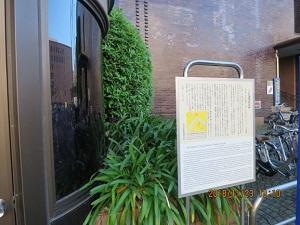
Ryoma initially goes from the Tosa clan Kajibashi clan residence Nagaya to the Sadakichi Chiba dojo in Okemachi (2-8 Yaesu, Chuo-ku). Regarding this background, in Ryoma Goes, "I say" Yoraba Daiki's shadow. After all, in order to make a great success, it is better to learn a great style. For that, the Kitashinichi sword style is good. "Oh, don't you be a teacher of Shusaku Chiba." The Xuanwu-kan in Chiba is said to be the three major dojos in Edo, along with Shunzo Momoi on the banks of Kyobashi clams and Yakuro Saito in Kojimachi, and divided the swords of the world into three parts. "... It's best to learn from Mr. Shusaku, but since he's already in old age, it's good to be used by Mr. Sadayoshi, his younger brother who has a dojo in Kyobashi Okemachi. Mr. Sadayoshi's dojo is called Kochiba against Otamagaike Pond's Ochiba. "(Bunshun Bunko Volume; Page 18).
![IMG_1725[1]. jpg](https://en.tokuhain.chuo-kanko.or.jp/archive/2018/11/23/IMG_1725%5B1%5D.jpg)
late Tokugawa shogunate swordsman Matsuzaki Namishiro describes the characteristics of the three major dojos as "Chiba of Techniques (Xuanwu Museum), dignified Momoi (Shigakukan), and the Saito of Power (Nenheikan). Yakuro Saito is a religious style of Shinto.
At first, Hanpeita Takechi, who lived in the Tosa clan's residence Nagaya, said, `` At the head of the school of Mr. Shunzo Momoi on the shore of the clam, a master who enters three fingers in Edo in the Kagamishin Akechi style '' (Bunshun Bunko 1 volume; page 83).
Regarding this "Ijiri riverbank", "Monoshiri Encyclopedia" states that "There is an explanation board on the site" (page 42), but the exact position seems to be a little far away. The explanation board is installed in Kyobashi Park near the current Kyobashi Plaza (opened in July 1999) at the site of the former Kyobashi Elementary School (closed in 1992).
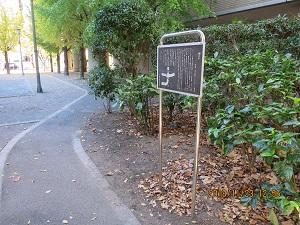
After that, an explanation board was installed at the site of the warship training center where Ryoma passed ("Monoshiri Encyclopedia"). In Ryoma Goku, "One bridge from Tsukiji Honganji and cross the east to Minami-Odawara-cho." It smells of the sea. Going further east, there was a corner where the former residence of the Geishu clan used to be located, where the Shogunate's Kobusho was located until very recently, and beyond it is the sea. There, since 1857, the Shogunate's warship training center has been set up." (Bunshun Bunko 3 volume; page 175).
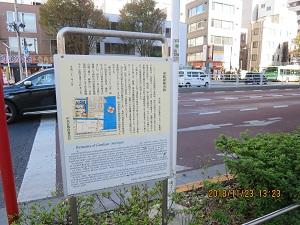
|
Links
|













































![IMG_1725[1]. jpg](https://en.tokuhain.chuo-kanko.or.jp/archive/2018/11/23/IMG_1725%5B1%5D.jpg)

